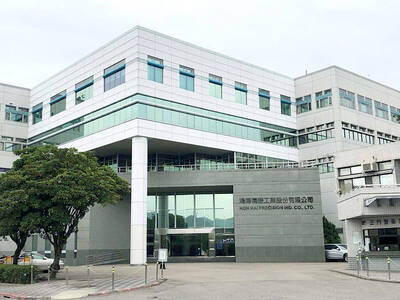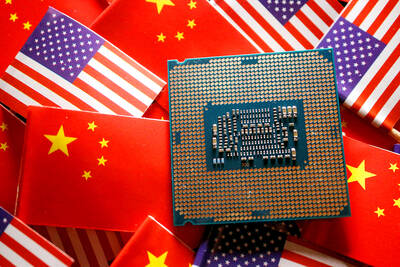It looks like the perfect business opportunity. Every house has one. Everyone uses them. And one Japanese company is making the most technologically advanced products of their kind.
But while the world may beat a path to your door for building a better mousetrap, Toto Ltd has found that selling a better toilet requires more patience.
Toto, the world's dominant maker of high-tech loos, made toilet history in 1980 when, improving on a US model that combined the bidet and the toilet, it produced the "washlet" -- bringing warm water to the user's nether regions.
"We did what others were reluctant to try -- we brought electronics into the water closet," said Hiroshi Kobayashi, Toto's general manager of restroom product research.
Sometimes dubbed "super-thrones," top-of-the-line washlets now come with wall-mounted control panels as sleek and complex as those of stereo systems.
Their manifold buttons allow adjustment of the nozzle position, water pressure and type of spray, plus blow-drying, air purification and seat warming for those cold winter mornings. Water and seat temperatures are adjustable.
The controls can also be set so the lid rises as the toilet is approached.
Japan has embraced the high-tech toilet. Government statistics show that combined toilet/bidets are now installed in 52 percent of Japanese homes compared to just 14 percent in 1992.
Toto -- which employs around 1,500 engineers -- dominates that market with a 65 percent share. Its closest rival, Japan's Inax Corp, trails at 25 percent. Numbers for Japan's overall toilet market share are similar.
But where Sony's Playstation, Toyota Corollas and Pokemon have all blazed paths into western popular culture, Toto's high-tech thrones have not traveled well.
Toto officials blame matters both cultural and practical.
A relatively long history of flush toilets in the US and Europe -- around 100 years -- has resulted in many competitors and cheap toilets.
Westerners just aren't used to shelling out hundreds or even thousands of dollars for high-tech versions.
Most Western bathrooms also lack an electric socket near the toilet, something that people in Japan, where central heating is rare, were keen to install when the seat-warmer was introduced.
But after making some inroads in the US with more standard models, especially with the advent of low-flow toilets in the 1990s, Toto's washlets are starting to make an impression.
Its US washlet sales, which began some eight years ago, have risen to over 1,000 units a month this year from 600 two years ago.
"It's not the same amount of numbers but the trend is very similar to what we saw in Japan 20 years ago -- low figures for about five years and then a sharp J-curve. We have great expectations for US sales next year," Kobayashi said.
But marketing toilets is not easy. Building showrooms is expensive and some analysts estimate it will take another five years before overseas revenues, now only 5 percent of Toto's total sales, climb to 10 percent.
And some cultural barriers seem to be just too hard to break -- witness the European market, where Toto has only one distributor and sells a mere 5,000 washlets annually.
"You'd think that because Europeans are used to the bidet, they'd be more interested. We just don't know why they aren't," said Kobayashi.
Some analysts even argue that tackling cultural norms isn't worth the effort and that Toto would be better off pulling its washlets out of the US and Europe altogether and concentrating on more receptive Asian markets like China.

Shares in Taiwan closed at a new high yesterday, the first trading day of the new year, as contract chipmaker Taiwan Semiconductor Manufacturing Co (TSMC, 台積電) continued to break records amid an artificial intelligence (AI) boom, dealers said. The TAIEX closed up 386.21 points, or 1.33 percent, at 29,349.81, with turnover totaling NT$648.844 billion (US$20.65 billion). “Judging from a stronger Taiwan dollar against the US dollar, I think foreign institutional investors returned from the holidays and brought funds into the local market,” Concord Securities Co (康和證券) analyst Kerry Huang (黃志祺) said. “Foreign investors just rebuilt their positions with TSMC as their top target,

REVENUE PERFORMANCE: Cloud and network products, and electronic components saw strong increases, while smart consumer electronics and computing products fell Hon Hai Precision Industry Co (鴻海精密) yesterday posted 26.51 percent quarterly growth in revenue for last quarter to NT$2.6 trillion (US$82.44 billion), the strongest on record for the period and above expectations, but the company forecast a slight revenue dip this quarter due to seasonal factors. On an annual basis, revenue last quarter grew 22.07 percent, the company said. Analysts on average estimated about NT$2.4 trillion increase. Hon Hai, which assembles servers for Nvidia Corp and iPhones for Apple Inc, is expanding its capacity in the US, adding artificial intelligence (AI) server production in Wisconsin and Texas, where it operates established campuses. This

US President Donald Trump on Friday blocked US photonics firm HieFo Corp’s US$3 million acquisition of assets in New Jersey-based aerospace and defense specialist Emcore Corp, citing national security and China-related concerns. In an order released by the White House, Trump said HieFo was “controlled by a citizen of the People’s Republic of China” and that its 2024 acquisition of Emcore’s businesses led the US president to believe that it might “take action that threatens to impair the national security of the United States.” The order did not name the person or detail Trump’s concerns. “The Transaction is hereby prohibited,”

Garment maker Makalot Industrial Co (聚陽) yesterday reported lower-than-expected fourth-quarter revenue of NT$7.93 billion (US$251.44 million), down 9.48 percent from NT$8.76 billion a year earlier. On a quarterly basis, revenue fell 10.83 percent from NT$8.89 billion, company data showed. The figure was also lower than market expectations of NT$8.05 billion, according to data compiled by Yuanta Securities Investment and Consulting Co (元大投顧), which had projected NT$8.22 billion. Makalot’s revenue this quarter would likely increase by a mid-teens percentage as the industry is entering its high season, Yuanta said. Overall, Makalot’s revenue last year totaled NT$34.43 billion, down 3.08 percent from its record NT$35.52